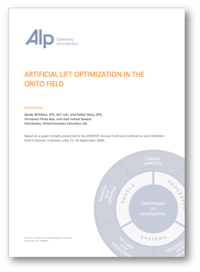
The Orito field located in the South of Colombia, near the Ecuadorian border has been in production since 1967 and is operated by the Colombian state oil company, Ecopetrol (originally discovered and exploited by Texaco). Petrominerales signed an Incremental Production Contract agreement in April 2001 to participate with Ecopetrol in increasing production from the field. Under the terms of the agreement Petrominerales invest 100% of any development activity in return for a portion of the value of the incremental production.
The Orito reservoir is a multi-layered reservoir with three production intervals: Pepino, Villeta and Caballos at depths of 3000 ft TVD and 7000 ft TVD respectively. The reservoirs are depleted, and pressures are below the original bubble point pressure. The wells can exhibit a number of challenges for production of fluids using artificial lift including: scale; solids production; high GOR; early high-water production; and also, very high CO2 (80%). Solids issues are exacerbated on wells where hydraulic frac jobs have been performed, which have resulted in a number of premature failures (less than 14 days) of ESP systems.
Artificial lift has been applied to the field and most lift methods have been tried at some point including Electric Submersible Pumps (ESPs), Rod Pumps, Gaslift, Jet Pumps and Progressing Cavity Pumps (PCPs). This paper will: identify the challenges associated with each lift method in this operating environment; present a lift method selection philosophy; provide details of a pilot program to convert Gas lifted wells to rod pump and; document the key steps taken to evolve an ESP design capable of producing the solids from the fractured wells.
.jpg?width=2097&height=770&name=ALP%20logo%20%26%20strapline%20-%20RGB%20(US%20version).jpg)